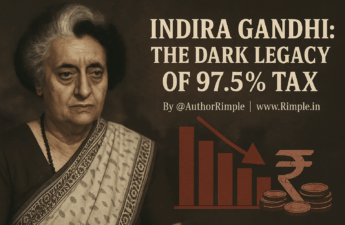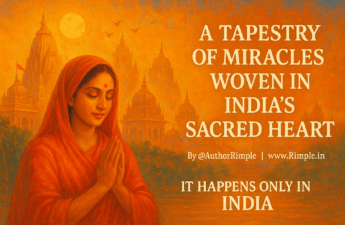In the heart of ancient India, where rivers whispered sacred hymns and mountains stood as silent sages, a luminous soul was born to illuminate the path of truth. Adi Shankaracharya, the divine philosopher, saint, and poet, emerged as a beacon of wisdom, uniting the scattered threads of Hindu thought into a tapestry of eternal unity. His life, a celestial melody, resonates through time, guiding seekers toward the infinite. From his humble beginnings to his final breath, Shankaracharya’s journey was a pilgrimage of the soul, weaving devotion, knowledge, and unity across the land. This is his story—flowing like the sacred Ganga, divine as the morning sun, and beautiful as the lotus in bloom.
A Star is Born: The Childhood of Shankaracharya
In the serene village of Kalady, nestled along the Periyar River in Kerala, around 788 CE, a divine child was born to a devout Brahmin couple, Shivaguru and Aryamba. Named Shankara, meaning “bestower of auspiciousness,” the boy was a gift from Lord Shiva himself, granted after years of fervent prayers. From his earliest days, Shankara’s brilliance shone like the rising sun, his eyes sparkling with a wisdom far beyond his years.
- A Prodigy’s Beginnings: By age three, Shankara recited Vedic hymns with flawless precision, astonishing the village elders. His mother, Aryamba, nurtured his spiritual curiosity, while his father, Shivaguru, introduced him to the scriptures.
- The Call of Destiny: At five, tragedy struck when Shivaguru passed away. Yet, young Shankara’s resolve grew stronger. He performed his father’s last rites with grace, displaying maturity that moved all who witnessed it.
- A Sacred Vow: By eight, Shankara felt the pull of renunciation. With his mother’s reluctant blessing, he took sannyasa (monastic vows), promising to dedicate his life to the pursuit of truth.
As a young sannyasi, Shankara’s heart sang of the divine, his mind sharp as a diamond, cutting through illusion. His journey was about to unfold, a sacred pilgrimage that would transform the spiritual landscape of India.
The Quest for Truth: Meeting the Guru
With a heart full of devotion and a mind seeking the ultimate truth, Shankara wandered north to the banks of the Narmada River. There, in a cave at Omkareshwar, he met his guru, Govinda Bhagavatpada, a sage steeped in the wisdom of Advaita (non-dualism).
- The Guru’s Grace: Under Govinda’s guidance, Shankara mastered the Upanishads, Bhagavad Gita, and Brahma Sutras. His guru recognized him as a divine incarnation, destined to revive the eternal truths of Sanatana Dharma.
- The Spark of Advaita: Govinda taught Shankara the essence of Advaita Vedanta—that the individual soul (Atman) and the universal consciousness (Brahman) are one. This truth became the cornerstone of Shankara’s philosophy.
In the stillness of the cave, Shankara composed his first verses, his words flowing like a river of light:
आत्मा त्वं गिरिजा मतिः सहचराः प्राणाः शरीरं गृहम्
पूजा ते विषयोपभोगरचना निद्रा समाधिस्थितिः
Atma tvam girija matih sahacharah pranah shariram griham
Puja te vishayopabhogarachana nidra samadhisthitih)
Translation: You are the Self, O Goddess, the mind is your companion, the senses are your attendants, the body is your home. Worship is the enjoyment of sense objects, and sleep is the state of samadhi.
Meaning: In this verse from Saundarya Lahari, Shankara reveals the divine unity underlying all existence, where every aspect of life is an offering to the Supreme.
These verses, radiant with insight, marked the beginning of Shankara’s mission to awaken humanity to the truth of oneness.
Walking the Land: Uniting a Nation
At sixteen, Shankara set forth on a divine mission to revive Hinduism, which had fragmented under the weight of ritualism and competing philosophies. Barefoot, with only a staff and a heart full of love for Brahman, he walked across India, from the snow-capped Himalayas to the southern shores of Kanyakumari, uniting Hindus through the power of wisdom and devotion.
- The Digvijaya Yatra: Shankara’s Digvijaya (spiritual conquest) was a journey of love, not war. He engaged in debates with scholars of every sect—Buddhists, Jains, Mimamsakas, and others—winning hearts with his logic and compassion.
- Establishing Unity: He founded four mathas (monasteries) in the four corners of India—Sringeri (South), Dwaraka (West), Puri (East), and Badrinath (North)—to preserve and propagate Advaita Vedanta. These mathas became beacons of spiritual learning, uniting diverse Hindu traditions.
- Reviving Temples and Rituals: Shankara rekindled devotion by reorganizing temple worship and composing hymns to deities like Shiva, Vishnu, and Shakti, showing that all paths lead to the same truth.
His footsteps sanctified the land, his words healed divisions, and his presence reminded all that beneath the diversity of names and forms lies the one eternal Brahman.
The Ocean of His Works: A Legacy of Light
Shankaracharya’s genius flowed through his writings, which remain a treasure trove of spiritual wisdom. His works, composed in lucid Sanskrit, are accessible yet profound, guiding both the scholar and the layman toward liberation. Let us explore his contributions, categorized for clarity, each a petal in the lotus of his legacy. His writings are more than 300 in numbers, here will cover just a few.
Stotras: Hymns of Divine Love
Shankaracharya’s stotras (devotional hymns) are rivers of bhakti, merging the heart’s devotion with the mind’s clarity. Sung in temples and homes, they awaken love for the divine.
Saundarya Lahari: A hymn to Goddess Shakti, blending devotion with tantric mysticism. Its 100 verses describe her beauty and power, guiding devotees to spiritual awakening.
Shivananda Lahari: A soul-stirring ode to Lord Shiva, expressing the ecstasy of surrender to the divine.
Bhaja Govindam: A simple yet profound call to seek God and renounce worldly attachments. Its opening verse urges:
भज गोविन्दं भज गोविन्दं गोविन्दं भक्तिमान्
(Bhaja Govindam Bhaja Govindam Govindam Bhaktiman)
Translation: Worship Govinda, worship Govinda, O devotee of Govinda!
Meaning: Shankara reminds us that true refuge lies in devotion to the divine, not in fleeting worldly pursuits.
Other Gems: Hymns like Dakshinamurti Stotra (to the silent teacher Shiva) and Annapurna Stotra (to the Goddess of nourishment) continue to inspire millions.
Commentaries: Illuminating the Scriptures
Shankara’s bhashyas (commentaries) on the Prasthanatrayi—the Upanishads, Bhagavad Gita, and Brahma Sutras—are his intellectual masterpieces, clarifying the path of Advaita.
Upanishad Bhashyas: His commentaries on the ten principal Upanishads (e.g., Chandogya, Brihadaranyaka, Mundaka) unravel the mysteries of the Self and Brahman, making complex truths accessible.
Bhagavad Gita Bhashya: Shankara’s commentary on the Gita balances karma (action), bhakti (devotion), and jnana (knowledge), showing their unity in the quest for liberation.
Brahma Sutra Bhashya: This monumental work systematizes Advaita philosophy, refuting rival schools and establishing the non-dual nature of reality. A key verse he explains:
ब्रह्म सत्यं जगन्मिथ्या जीवो ब्रह्मैव नापरः
(Brahma satyam jaganmithya jivo brahmaiva naparah)
Translation: Brahman is real, the world is illusory, and the individual soul is none other than Brahman.
Meaning: This encapsulates Advaita’s core teaching—only Brahman exists, and all else is a transient appearance.
Independent Works: Pearls of Wisdom
Shankara’s prakarana granthas (introductory texts) distill Advaita’s essence for beginners, each a stepping stone to self-realization.
Atmabodha: A concise treatise on self-knowledge, comparing the Self to a lamp that shines eternally.
आत्मबोधोऽहम् आत्मबोधोऽहम् नाहं देहो न मनो न बुद्धिः
(Atmabodho’ham atmabodho’ham naham deho na mano na buddhih)
Translation: I am self-knowledge, I am self-knowledge; I am not the body, mind, or intellect.
Meaning: Shankara guides us to identify with the eternal Self, beyond physical and mental limitations.
Vivekachudamani: A poetic masterpiece, it distinguishes the real (Brahman) from the unreal (world), urging discernment and meditation.
Upadesasahasri: A thousand teachings on the nature of the Self, blending logic and mysticism.
Other Works: Texts like Tattvabodha and Aparokshanubhuti offer clear, step-by-step guidance to liberation.
Through these works, Shankara built a bridge between the human and the divine, his words a ladder to the infinite.
The Final Ascent: His Last Breath
By his early thirties, Shankaracharya had accomplished what seemed impossible—uniting a nation, reviving a faith, and leaving a legacy that would endure for millennia. His final days are shrouded in divine mystery, with legends painting a picture of transcendence.
- The Kedarnath Legend: It is said that at 32, Shankara ascended to the snowy peaks of Kedarnath in the Himalayas. There, in the presence of Lord Shiva, he merged into the eternal Brahman, his physical form dissolving into light.
- A Life Complete: Having fulfilled his divine mission, Shankara left behind a united Hindu tradition, a philosophy of oneness, and a treasure of writings that continue to guide humanity.
As he departed, it was as if the stars themselves wept, yet his light remained, eternal and unchanging, guiding countless souls toward truth.
His Divine Legacy: A Light That Never Fades
Adi Shankaracharya’s life was a symphony of devotion, wisdom, and unity. He walked the length and breadth of India, not as a conqueror, but as a lover of truth, stitching together a fractured faith with the thread of Advaita. His teachings remind us that we are not separate, not bound by the illusions of the world, but one with the infinite Brahman.
- A United Hinduism: By establishing the mathas and standardizing worship, he gave Hinduism a cohesive identity, embracing its diversity while rooting it in unity.
- A Philosophy for All: Advaita Vedanta, through Shankara’s works, offers a universal path to liberation, accessible to all, regardless of caste, creed, or status.
- A Timeless Inspiration: His hymns and teachings continue to be chanted, studied, and lived, their simplicity touching the layman, their depth humbling the scholar.
In the quiet of dawn, when a devotee sings Bhaja Govindam, or a seeker meditates on Atmabodha, Shankaracharya’s presence is felt—a gentle whisper of divinity, a reminder that we are all one, eternal, and free.
A Poetic Farewell
O Shankara, light of the ages, your footsteps echo in the heart of India. You walked through forests and mountains, carrying the torch of truth. Your words, like stars, guide us through the night of illusion. In your hymns, we hear the divine; in your teachings, we find ourselves. You are the river that merges into the ocean, the soul that returns to Brahman. Forever, you shine, O divine master, in the lotus of our hearts.





